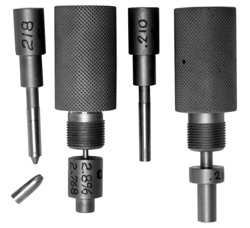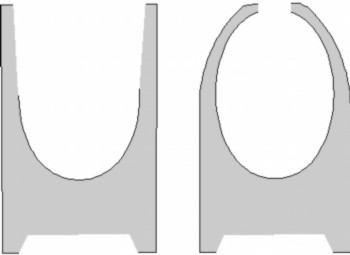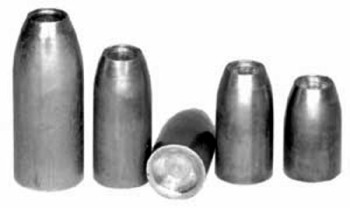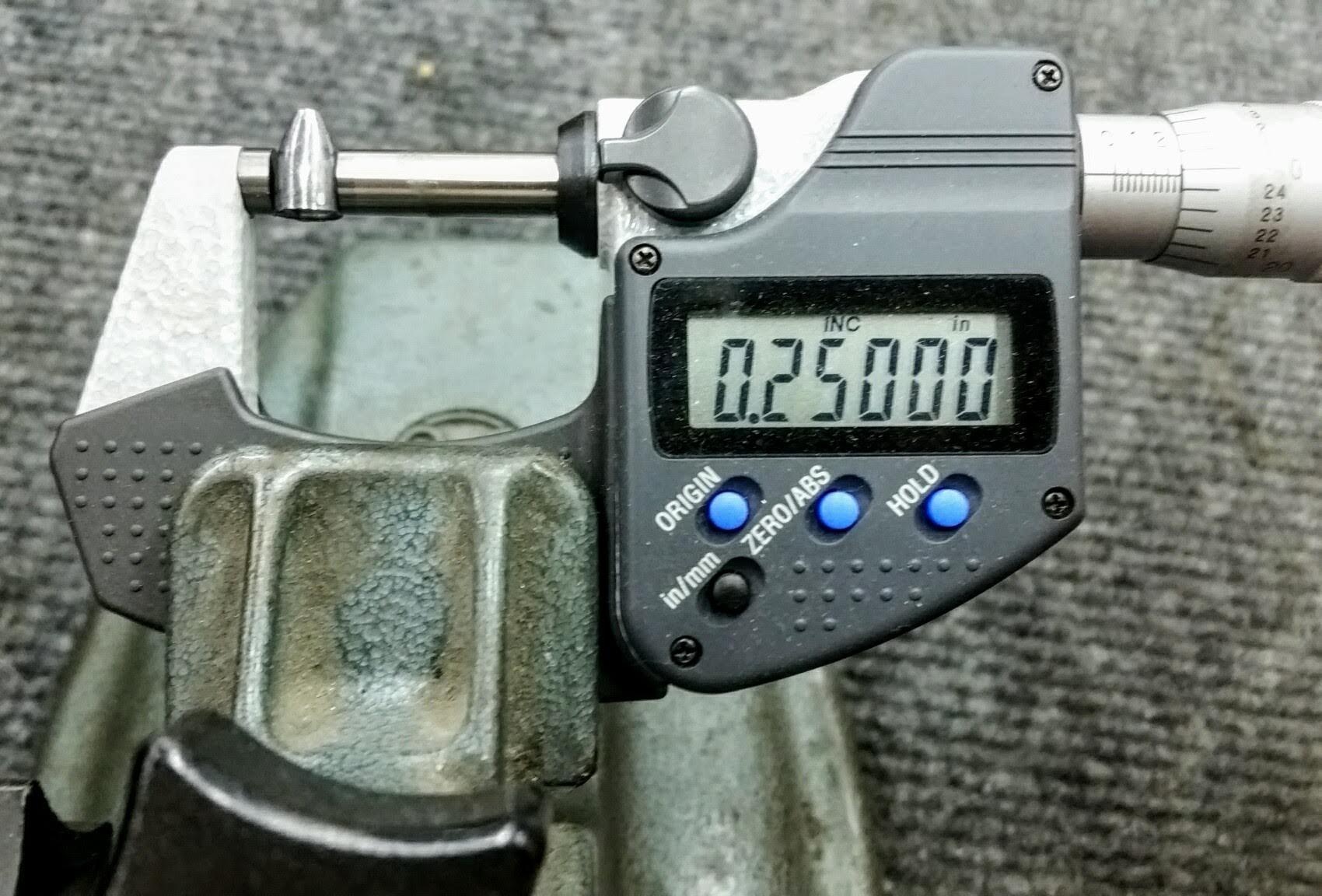|
|
|
Air Gun 2-die Hollow Ogive set
|
| |

|
Quantity in Basket:
None
Catalog No.: PFHO-2SP
Price: $828.00
Shipping Weight: 1.00 pounds
Sorry, we are no longer taking orders for the Air Gun 2-die Hollow Ogive set on our legacy website. Please visit our new website at Corbins.com for all future orders. Any question/concerns you can reach us at sales@corbins.com Thank you
|
| |
This is a 2-die set used to produce a hollow ogive air gun slug. The body of the projectile has an oval or egg-shaped cavity, with the opening smaller than the major ID. This style cannot be formed in a single step, since the conventional hollow point is made by inserting and removing a punch while forming the ogive around it. Obviously, if the punch was larger at the end, it could not be pulled back out of the same hollow point opening. So, the hollow body cavity is formed by rolling the ogive around a pre-formed hollow cavity in a cylinder shaped core.
 The set consists of two dies. The first is a core swage die. It is a straight cylinder shape, with a cavity just slightly smaller than the final, desired caliber. For example, you might use a 0.210 to 0.214 diameter core swage for finished bullets of .216 to .218 caliber. Exact size is not important so long as the core will fit into the second (point forming) die easily, and yet is not so far undersized that it wants to fold unevenly as the ogive is shaped. For instance, you could try using a .210 core swage for making a .224 slug, but it probably would not form as even and smooth of a meplat as a .220 diameter core. And if you tried to use it for larger sizes, such as .250 diameter, it would be quite unlikely to make a satisfactory projectile.
The set consists of two dies. The first is a core swage die. It is a straight cylinder shape, with a cavity just slightly smaller than the final, desired caliber. For example, you might use a 0.210 to 0.214 diameter core swage for finished bullets of .216 to .218 caliber. Exact size is not important so long as the core will fit into the second (point forming) die easily, and yet is not so far undersized that it wants to fold unevenly as the ogive is shaped. For instance, you could try using a .210 core swage for making a .224 slug, but it probably would not form as even and smooth of a meplat as a .220 diameter core. And if you tried to use it for larger sizes, such as .250 diameter, it would be quite unlikely to make a satisfactory projectile.
The core swage could also be called a LSWC-1 die, since the two are idential in general design. The only difference is in the purpose, which in turn might affect the diameter and the punch shapes used. A LSWC-1 die is a "lead semi-waductter" swage die, which also has a straight bore and bleed holes. But typically, the diameter is built to the finished projectile size, and the punches have ends shaped to create the base and nose of a shouldered or SWC bullet. The core swage is typically made smaller than the finished bullet, since the lead slug produced in it must fit into another die without difficulty. Also, the core swage typically has flat end punches. But in this special case, we use a large round-tipped projection on the nose punch, and may use a more shallow cup base projection on the other punch.
 After forming a large hollow cavity in one end of the lead cyliner (core), it is placed in the second die with the cavity facing into the die (toward the ogive or nose). This is facing down, toward the ram. As the base punch (mounted in a punch holder in the press head) pushes the core into the point forming die, the curved walls of the point forming die compress the walls of the cylinder inward. You can push the core all the way to the end of the point forming die, which makes the smallest tip. The closure at the tip will be smaller than the cavity diameter further inside the ogive. This makes it possible to create a lighter projectile for the same caliber and length as compared to a conventional hollow point (which has much thicker walls around the hollow cavity).
After forming a large hollow cavity in one end of the lead cyliner (core), it is placed in the second die with the cavity facing into the die (toward the ogive or nose). This is facing down, toward the ram. As the base punch (mounted in a punch holder in the press head) pushes the core into the point forming die, the curved walls of the point forming die compress the walls of the cylinder inward. You can push the core all the way to the end of the point forming die, which makes the smallest tip. The closure at the tip will be smaller than the cavity diameter further inside the ogive. This makes it possible to create a lighter projectile for the same caliber and length as compared to a conventional hollow point (which has much thicker walls around the hollow cavity).
 This set uses a point forming die has a synchronized ejector and bleed hole, which you don't use in making hollow ogive slugs since the core is already adjusted to exact weight. The cavity would be collapsed if enough pressure was applied so that the lead could flow. Just roll the ogive around gently, without crushing the hollow ogive shape.
This set uses a point forming die has a synchronized ejector and bleed hole, which you don't use in making hollow ogive slugs since the core is already adjusted to exact weight. The cavity would be collapsed if enough pressure was applied so that the lead could flow. Just roll the ogive around gently, without crushing the hollow ogive shape.
Please note that it is possible to make both a shouldered pellet in the first die if you add an optional SWC nose punch, as well as using both dies to make the smooth ogive hollow body slugs, using the large HP cavity punch. You would simply need to order a different internal punch to create the nose shape, instead of the deep hollow cavity internal punch. The PF-1-SP can be used by itself to make a solid ogive slug.
|
|









The set consists of two dies. The first is a core swage die. It is a straight cylinder shape, with a cavity just slightly smaller than the final, desired caliber. For example, you might use a 0.210 to 0.214 diameter core swage for finished bullets of .216 to .218 caliber. Exact size is not important so long as the core will fit into the second (point forming) die easily, and yet is not so far undersized that it wants to fold unevenly as the ogive is shaped. For instance, you could try using a .210 core swage for making a .224 slug, but it probably would not form as even and smooth of a meplat as a .220 diameter core. And if you tried to use it for larger sizes, such as .250 diameter, it would be quite unlikely to make a satisfactory projectile.
After forming a large hollow cavity in one end of the lead cyliner (core), it is placed in the second die with the cavity facing into the die (toward the ogive or nose). This is facing down, toward the ram. As the base punch (mounted in a punch holder in the press head) pushes the core into the point forming die, the curved walls of the point forming die compress the walls of the cylinder inward. You can push the core all the way to the end of the point forming die, which makes the smallest tip. The closure at the tip will be smaller than the cavity diameter further inside the ogive. This makes it possible to create a lighter projectile for the same caliber and length as compared to a conventional hollow point (which has much thicker walls around the hollow cavity).
This set uses a point forming die has a synchronized ejector and bleed hole, which you don't use in making hollow ogive slugs since the core is already adjusted to exact weight. The cavity would be collapsed if enough pressure was applied so that the lead could flow. Just roll the ogive around gently, without crushing the hollow ogive shape.























